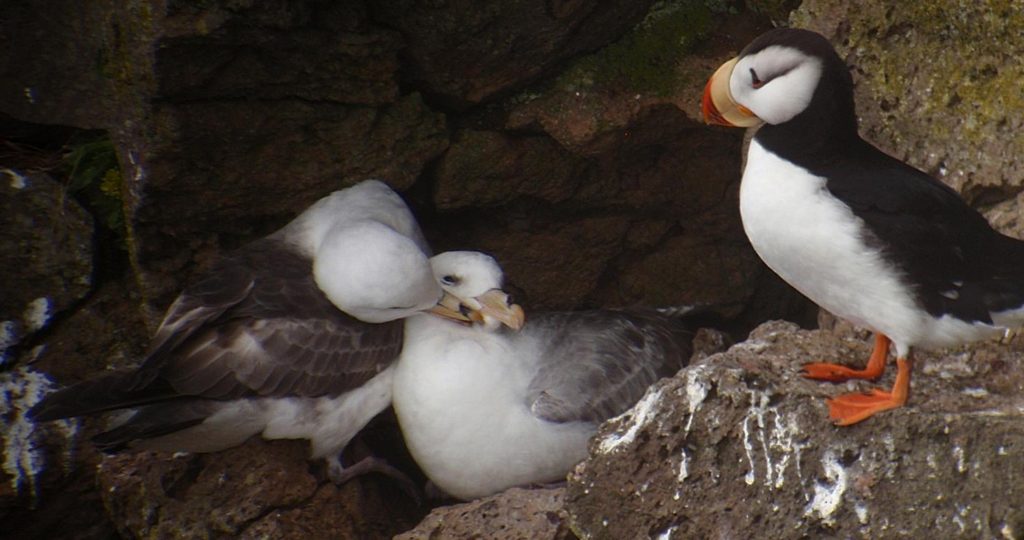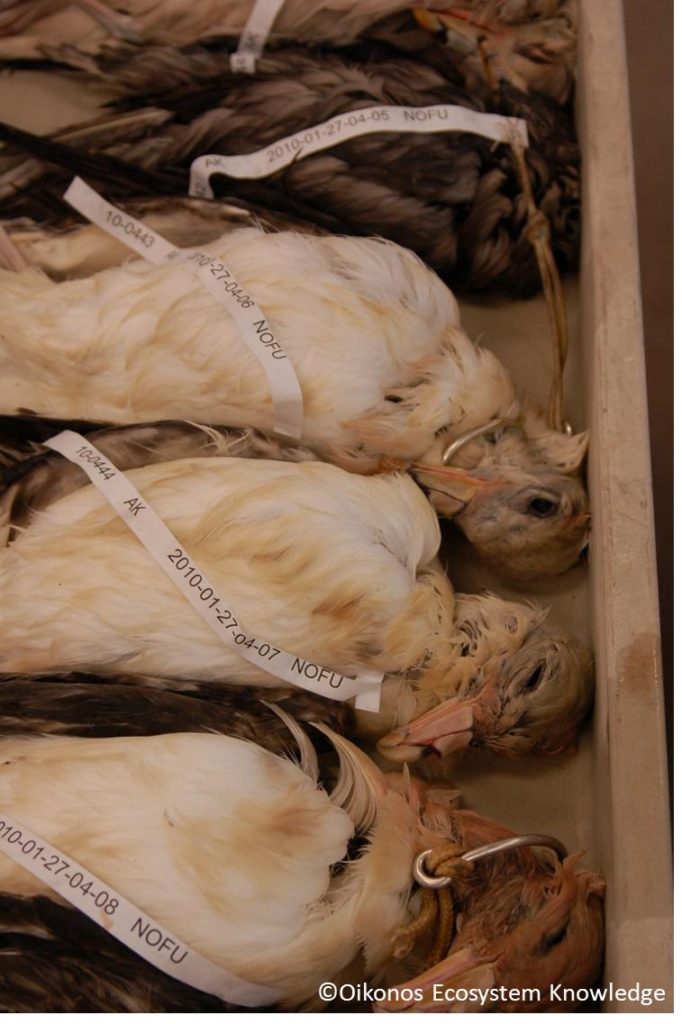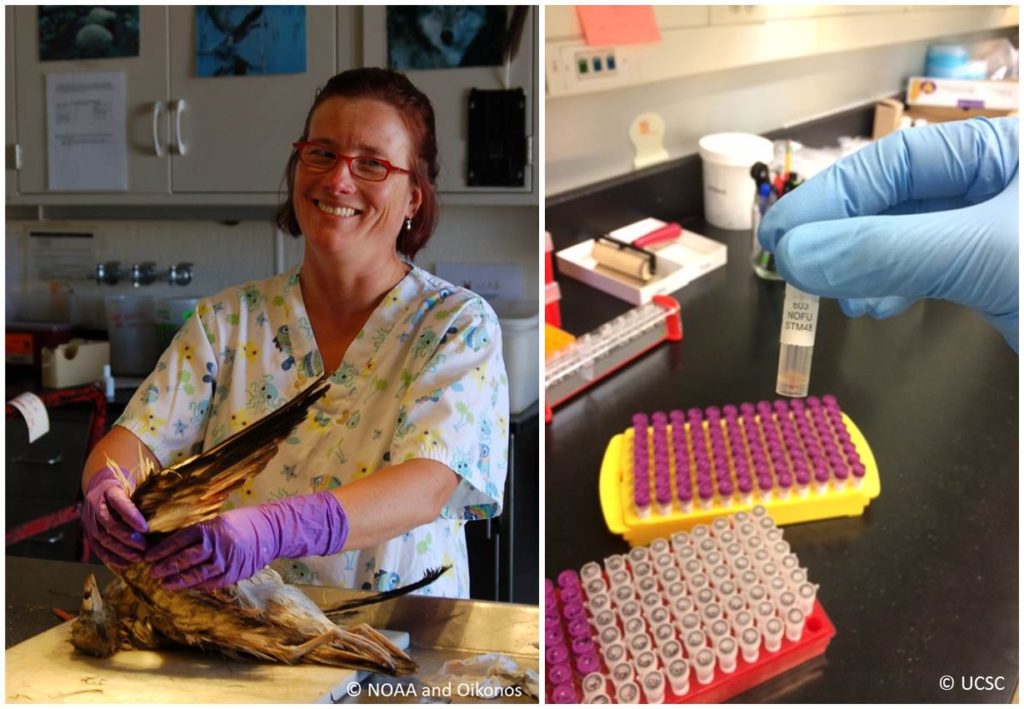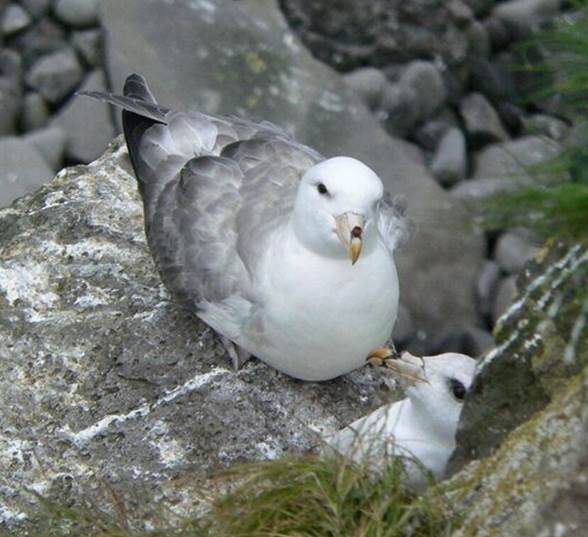In the spring, commercial fishing boats spread out in Alaskan waters (all the way from the Gulf of Alaska to the Aleutian Islands to the Bering Sea) to fish for cod turbot, halibut and other fish species. These boats are part of the North Pacific groundfish and Pacific halibut fisheries.During the same time, Northern Fulmars are also beginning to breed at their four main colonies in Alaska: the Pribilof Islands, St. Matthew and Hall Islands, the Semidi Islands, and Chagulak Island. Fulmar parents need to bulk up before the breeding season starts because laying an egg takes energy and they will need to work extra hard to find food for their chicks. It’s important that they start off the breeding season healthy and strong.

Northern Fulmars preen each other as a Horned Puffin looks on. Photo by Caitlin Kroeger.
Northern Fulmars fly hundreds of miles to find food floating on the surface of the ocean. When they see or smell a fishing boat nearby, fulmars can be attracted to the small pieces of discarded fish and bait on the hooks from the fishing boats. When they are accidentally caught by the fishing hooks they become bycatch or animals that are accidentally caught in the process of fishing.
The federal government agency NOAA (National Atmospheric and Oceanic Administration) puts observers on some fishing boats to collect data. They collect many types of data, like the lengths of halibut caught, types of animals caught as bycatch, and more. These observers also save some of the dead fulmars caught as bycatch for researchers to study.
The observers send the fulmars to scientists to necropsy or dissect as part of the Seabird Bycatch Necropsy Program. Necropsying a bird can give NOAA and the fishing community important information about whether the bird is a male or female, whether they were breeding, what they eat and more.

Northern Fulmars caught as bycatch are necropsied to understand more about the sex and age of fulmars caught in fishery bycatch. Photo by Oikonos Ecosystem Knowledge.
Researchers from NOAA, Oikonos, and the University of California Santa Cruz were curious about which colonies the fulmar bycatch came from, and whether more birds came from certain colonies. They wanted to know whether some colonies were more affected than others – or disproportionately affected.
Birds at different colonies can be genetically different if few birds breed with birds from other colonies. If certain colonies are disproportionately affected by fishery bycatch, it therefore could reduce the genetic diversity of the fulmars in the overall population. For example, if there were more birds from Chagulak being caught and the Chagulak birds were genetically different from the rest of the population, there would be fewer birds with Chagulak genes in the overall fulmar population.
To study this, the North Pacific Research Board gave researchers a grant to look at the genetics of the bycatch fulmars as part of the Northern Fulmar Genetics Project. The researchers collected small pieces of muscle from 1,536 bycatch fulmars in the Seabird Bycatch Necropsy Program and looked at the DNA of each bird. In the DNA, they looked for genetic markers they had developed for each of the four colonies. When a bird had a marker from one colony, for example a marker for Chagulak Island, the researchers considered that bird to have hatched on Chagulak.

Left: Angie Reed examines a Northern Fulmar caught as bycatch (photo by Oikonos). Right: She will sample the birds muscle for a genetics sample (photo by UCSC).
The researchers then looked at how many bycatch fulmars came from each colony compared to the size of the colony. In our example, if Chagulak’s fulmar population made up 25% of the total Alaska population, the researchers expected that 25% of the bycatch fulmars would come from Chagulak. If more than 25% of the bycatch fulmars came from Chagulak, there could be disproportionate removal of fulmars from that colony.
After working on this project for two years, the researchers finally had some results.
They found that disproportionately more bycatch fulmars came from the Pribilof Islands, while fewer than expected fulmars came from Chagulak. The Pribilof Islands make up roughly 6% of the Alaska fulmar population, but made up between 21-23% of the bycatch. This may be due to the amount of fishing that happens around the Pribilofs, where many boats fish for Pacific cod. Perhaps there is less fishing occurring around Chagulak, which is farther west in the Aleutians. Or perhaps these results are related to fulmar or fishermen behavior.
The next step was to understand if the genetic makeups at the different colonies were distinct enough that disproportionate removal of fulmars would impact the overall genetic diversity of the species. This would happen if the fulmars on the islands bred mostly with other fulmars on the same island.
Researchers found the opposite. They found that birds from different colonies were breeding with each other, and that the different colonies were not that distinct from each other. That meant that although more Pribilof fulmars were being caught than fulmars from other colonies, the disproportionate removal likely did not impact the overall genetic diversity of the species.
More research needs to be done to understand whether the disproportionate removal of birds from the Pribilofs has other impacts. For example, fewer fulmars breeding on the Pribilof Islands could affect species that eat fulmar adults or eggs, like gulls. Or maybe removing fulmars affects the amount of nutrients on the islands delivered by the fulmar feces. However, researchers now have a better understanding of which colonies fulmar bycatch comes from and that the genetic diversity of the species is likely not being impacted by fisheries bycatch.

Northern Fulmars roosting at St. George Island. Photo: Rachael Orben
